Potential Valorization of Waste Tires as Activated Carbon-Based Adsorbent for Organic Contaminants Removal
Abstract
:1. Introduction
2. Materials and Methods
2.1. Waste Tires Feedstock
2.2. Thermogravimetric Analysis Experiments
2.3. Pilot-Scale Pyrolysis Experiments
2.4. Activation Experiments
2.5. Chemical and Physical Characterization
2.6. Aqueous Phase Adsorption Tests
3. Results and Discussion
3.1. Thermogravimetric Analysis
3.2. Product Yields
3.3. Characterization of the Chars
3.4. Characterization of the Activated Chars
3.5. Adsorption Tests
4. Conclusions
Author Contributions
Funding
Institutional Review Board Statement
Informed Consent Statement
Data Availability Statement
Acknowledgments
Conflicts of Interest
References
- Mastral, A.M.; Callén, M.S.; Murillo, R.; García, T. Combustion of High Calorific Value Waste Material: Organic Atmospheric Pollution. Environ. Sci. Technol. 1999, 33, 4155–4158. [Google Scholar] [CrossRef]
- Sathiskumar, C.; Karthikeyan, S. Recycling of Waste Tires and Its Energy Storage Application of By-Products–A Review. Sustain. Mater. Technol. 2019, 22, e00125. [Google Scholar] [CrossRef]
- Song, W.; Zhou, J.; Li, Y.; Li, S.; Yang, J. Utilization of Waste Tire Powder for Gaseous Fuel Generation via CO2 Gasification Using Waste Heat in Converter Vaporization Cooling Flue. Renew. Energy 2021, 173, 283–296. [Google Scholar] [CrossRef]
- Fernández, A.M.; Barriocanal, C.; Alvarez, R. Pyrolysis of a Waste from the Grinding of Scrap Tyres. J. Hazard. Mater. 2012, 203–204, 236–243. [Google Scholar] [CrossRef]
- Directive 2000/53/EC of the European Parliament and of the Council of 18 September 2000 on End-of Life Vehicles. Available online: https://eur-lex.europa.eu/LexUriServ/LexUriServ.do?uri=CONSLEG:2000L0053:20050701:EN:PDF (accessed on 27 December 2021).
- Hita, I.; Arabiourrutia, M.; Olazar, M.; Bilbao, J.; Arandes, J.M.; Castaño Sánchez, P. Opportunities and Barriers for Producing High Quality Fuels from the Pyrolysis of Scrap Tires. Renew. Sustain. Energy Rev. 2016, 56, 745–759. [Google Scholar] [CrossRef]
- Council Directive 1999/31/EC of 26 April 1999 on the Landfill of Waste. Available online: https://eur-lex.europa.eu/legal-content/EN/TXT/PDF/?uri=CELEX:31999L0031&from=en (accessed on 27 December 2021).
- Galvagno, S.; Casu, S.; Casabianca, T.; Calabrese, A.; Cornacchia, G. Pyrolysis process for the treatment of scrap tyres: Preliminary experimental results. Waste Manag. 2002, 22, 917–923. [Google Scholar] [CrossRef]
- Chen, D.; Yin, L.; Wang, H.; He, P. Pyrolysis Technologies for Municipal Solid Waste: A Review. Waste Manag. 2014, 34, 2466–2486. [Google Scholar] [CrossRef]
- Kyari, M.; Cunliffe, A.; Williams, P.T. Characterization of Oils, Gases, and Char in Relation to the Pyrolysis of Different Brands of Scrap Automotive Tires. Energy Fuels 2005, 19, 1165–1173. [Google Scholar] [CrossRef]
- Frigo, S.; Seggiani, M.; Puccini, M.; Vitolo, S. Liquid fuel production from waste tyre pyrolysis and its utilisation in a Diesel engine. Fuel 2004, 116, 399–408. [Google Scholar] [CrossRef]
- Rodriguez, I.d.M.; Laresgoiti, M.F.; Cabrero, M.A.; Torres, A.; Chomón, M.J.; Caballero, B. Pyrolysis of Scrap Tyres. Fuel Process. Technol. 2001, 72, 9–22. [Google Scholar] [CrossRef]
- Laresgoiti, M.F.; Caballero, B.M.; de Marco, I.; Torres, A.; Cabrero, M.A.; Chomón, M.J. Characterization of the Liquid Products Obtained in Tyre Pyrolysis. J. Anal. Appl. Pyrolysis 2004, 71, 917–934. [Google Scholar] [CrossRef]
- Díez, C.; Martínez, O.; Calvo, L.F.; Cara, J.; Morán, A. Pyrolysis of Tyres. Influence of the Final Temperature of the Process on Emissions and the Calorific Value of the Products Recovered. Waste Manag. 2004, 24, 463–469. [Google Scholar] [CrossRef] [PubMed]
- Mohan, A.; Dutta, S.; Balusamy, S.; Madav, V. Liquid Fuel from Waste Tires: Novel Refining, Advanced Characterization and Utilization in Engines with Ethyl Levulinate as an Additive. RSC Adv. 2021, 11, 9807–9826. [Google Scholar] [CrossRef]
- Banar, M.; Akyıldız, V.; Özkan, A.; Çokaygil, Z.; Onay, Ö. Characterization of Pyrolytic Oil Obtained from Pyrolysis of TDF (Tire Derived Fuel). Energy Convers. Manag. 2012, 62, 22–30. [Google Scholar] [CrossRef]
- Williams, P.T.; Brindle, A.J. Aromatic Chemicals from the Catalytic Pyrolysis of Scrap Tyres. J. Anal. Appl. Pyrolysis 2003, 67, 143–164. [Google Scholar] [CrossRef]
- Williams, P.T.; Brindle, A.J. Catalytic Pyrolysis of Tyres: Influence of Catalyst Temperature. Fuel 2002, 81, 2425–2434. [Google Scholar] [CrossRef]
- Pakdel, H.; Pantea, D.M.; Roy, C. Production of Dl-Limonene by Vacuum Pyrolysis of Used Tires. J. Anal. Appl. Pyrolysis 2001, 57, 91–107. [Google Scholar] [CrossRef]
- Czajczyńska, D.; Krzyżyńska, R.; Jouhara, H.; Spencer, N. Use of Pyrolytic Gas from Waste Tire as a Fuel: A Review. Energy 2017, 134, 1121–1131. [Google Scholar] [CrossRef]
- Luo, S.; Feng, Y. The Production of Fuel Oil and Combustible Gas by Catalytic Pyrolysis of Waste Tire Using Waste Heat of Blast-Furnace Slag. Energy Convers. Manag. 2017, 136, 27–35. [Google Scholar] [CrossRef]
- Machin, E.B.; Pedroso, D.T.; de Carvalho, J.A. Energetic Valorization of Waste Tires. Renew. Sustain. Energy Rev. 2017, 68, 306–315. [Google Scholar] [CrossRef] [Green Version]
- Pathak, P.; Sinha, S. Valorisation of waste tires into fuel and energy. In Advanced Technology for the Conversion of Waste into Fuels and Chemicals; Khan, A., Pizzi, A., Jawaid, M., Azum, N., Asiri, A., Isa, I., Eds.; Elsevier: Amsterdam, The Netherlands, 2021; pp. 109–122. [Google Scholar]
- Xu, J.; Yu, J.; Xu, J.; Sun, C.; He, W.; Huang, J.; Li, G. High-Value Utilization of Waste Tires: A Review with Focus on Modified Carbon Black from Pyrolysis. Sci. Total Environ. 2020, 742, 140235. [Google Scholar] [CrossRef] [PubMed]
- Gómez-Hernández, R.; Panecatl-Bernal, Y.; Méndez-Rojas, M.Á. High Yield and Simple One-Step Production of Carbon Black Nanoparticles from Waste Tires. Heliyon 2019, 5, e02139. [Google Scholar] [CrossRef] [PubMed]
- Xu, J.; Yu, J.; He, W.; Huang, J.; Xu, J.; Li, G. Recovery of Carbon Black from Waste Tire in Continuous Commercial Rotary Kiln Pyrolysis Reactor. Sci. Total Environ. 2021, 772, 145507. [Google Scholar] [CrossRef] [PubMed]
- Williams, P.T.; Besler, S.; Taylor, D.T. The pyrolysis of scrap automotive tyres: The influence of temperature and heating rate on product composition. Fuel 1990, 69, 1474–1482. [Google Scholar] [CrossRef]
- Auer, E.; Freund, A.; Pietsch, J.; Tacke, T. Carbons as Supports for Industrial Precious Metal Catalysts. Appl. Catal. A Gen. 1998, 173, 259–271. [Google Scholar] [CrossRef]
- Dias, J.M.; Alvim-Ferraz, M.C.M.; Almeida, M.F.; Rivera-Utrilla, J.; Sánchez-Polo, M. Waste Materials for Activated Carbon Preparation and Its Use in Aqueous-Phase Treatment: A Review. J. Environ. Manag. 2007, 85, 833–846. [Google Scholar] [CrossRef]
- Lua, A.C.; Yang, T. Effect of Activation Temperature on the Textural and Chemical Properties of Potassium Hydroxide Activated Carbon Prepared from Pistachio-Nut Shell. J. Colloid Interface Sci. 2004, 274, 594–601. [Google Scholar] [CrossRef]
- Molina-Sabio, M.; Gonzalez, M.T.; Rodriguez-Reinoso, F.; Sepúlveda-Escribano, A. Effect of Steam and Carbon Dioxide Activation in the Micropore Size Distribution of Activated Carbon. Carbon 1996, 34, 505–509. [Google Scholar] [CrossRef]
- Lan, X.; Jiang, X.; Song, Y.; Jing, X.; Xing, X. The Effect of Activation Temperature on Structure and Properties of Blue Coke-Based Activated Carbon by CO2 Activation. Green Process. Synth. 2019, 8, 837–845. [Google Scholar] [CrossRef]
- Jun, T.Y.; Latip, N.H.A.; Abdullah, A.M.; Latif, P.A. Effect of Activation Temperature and Heating Duration on Physical Characteristics of Activated Carbon Prepared from Agriculture Waste. Environ. Asia 2010, 3, 143–148. [Google Scholar]
- Gao, Y.; Yue, Q.; Gao, B.; Li, A. Insight into Activated Carbon from Different Kinds of Chemical Activating Agents: A Review. Sci. Total Environ. 2020, 746, 141094. [Google Scholar] [CrossRef] [PubMed]
- Mozammel, H.M.; Masahiro, O.; SC, B. Activated Charcoal from Coconut Shell Using ZnCl2 Activation. Biomass Bioenergy 2002, 22, 397–400. [Google Scholar] [CrossRef]
- Suárez-García, F.; Martínez-Alonso, A.; Tascón, J.M.D. Pyrolysis of Apple Pulp: Chemical Activation with Phosphoric Acid. J. Anal. Appl. Pyrolysis 2002, 63, 283–301. [Google Scholar] [CrossRef]
- Okman, I.; Karagöz, S.; Tay, T.; Erdem, M. Activated Carbons From Grape Seeds By Chemical Activation With Potassium Carbonate And Potassium Hydroxide. Appl. Surf. Sci. 2014, 293, 138–142. [Google Scholar] [CrossRef]
- Muniandy, L.; Adam, F.; Mohamed, A.R.; Ng, E.-P. The Synthesis and Characterization of High Purity Mixed Microporous/Mesoporous Activated Carbon from Rice Husk Using Chemical Activation with NaOH and KOH. Microporous Mesoporous Mater. 2014, 197, 316–323. [Google Scholar] [CrossRef]
- Streat, M.; Patrick, J.W.; Perez, M.J.C. Sorption of Phenol and Para-Chlorophenol from Water Using Conventional and Novel Activated Carbons. Water Res. 1995, 29, 467–472. [Google Scholar] [CrossRef]
- Helleur, R.; Popovic, N.; Ikura, M.; Stanciulescu, M.; Liu, D. Characterization and Potential Applications of Pyrolytic Char from Ablative Pyrolysis of Used Tires. J. Anal. Appl. Pyrolysis 2001, 58–59, 813–824. [Google Scholar] [CrossRef]
- Allen, J.L.; Gatz, J.L.; Eklund, P.C. Applications for Activated Carbons from Used Tires: Butane Working Capacity. Carbon 1999, 37, 1485–1489. [Google Scholar] [CrossRef]
- Brady, T.A.; Rostam-Abadi, M.; Rood, M.J. Applications for Activated Carbons from Waste Tires: Natural Gas Storage and Air Pollution Control. Gas Sep. Purif. 1996, 10, 97–102. [Google Scholar] [CrossRef]
- Simitzis, J.; Sfyrakis, J. Activated Carbon from Lignocellulosic Biomass-Phenolic Resin. J. Appl. Polym. Sci. 1994, 54, 2091–2099. [Google Scholar] [CrossRef]
- González, J.F.; Román, S.; Encinar, J.M.; Martínez, G. Pyrolysis of Various Biomass Residues and Char Utilization for the Production of Activated Carbons. J. Anal. Appl. Pyrolysis 2009, 85, 134–141. [Google Scholar] [CrossRef]
- Oliveira, L.S.; Franca, A.S. Low-Cost Adsorbents from Agri-Food Wastes. In Food Science and Technology: New Research; Greco, L.V., Bruno, M.N., Eds.; Nova Science Publishers: New York, NY, USA, 2008. [Google Scholar]
- Nahil, M.A.; Williams, P.T. Activated Carbons from Acrylic Textile Waste. J. Anal. Pyrolysis 2010, 89, 51–59. [Google Scholar] [CrossRef]
- Nagano, S.; Tamon, H.; Adzumi, T.; Nakagawa, K.; Suzuki, T. Activated Carbon from Municipal Waste. Carbon 2000, 38, 915–920. [Google Scholar] [CrossRef]
- Hjaila, K.; Baccar, R.; Sarrà, M.; Gasol, C.M.; Blánquez, P. Environmental impact associated with activated carbon preparation from olive-waste cake via life cycle assessment. J. Environ. Manag. 2013, 130, 242–247. [Google Scholar] [CrossRef] [PubMed]
- Suganya, S.; Kumar, P.S. Evaluation of environmental aspects of brew waste-based carbon production and its disposal scenario. J. Clean. Prod. 2018, 202, 244–252. [Google Scholar] [CrossRef]
- Chingombe, P.; Saha, B.; Wakeman, R.J. Sorption of Atrazine on Conventional and Surface Modified Activated Carbons. J. Colloid Interface Sci. 2006, 302, 408–416. [Google Scholar] [CrossRef]
- Tsai, W.T.; Chang, Y.M.; Lai, C.W.; Lo, C.C. Adsorption of Basic Dyes in Aqueous Solution by Clay Adsorbent from Regenerated Bleaching Earth. Appl. Clay Sci. 2005, 29, 149–154. [Google Scholar] [CrossRef]
- Zhang, Z.; O’Hara, I.M.; Kent, G.A.; Doherty, W.O.S. Comparative Study on Adsorption of Two Cationic Dyes by Milled Sugarcane Bagasse. Ind. Crops Prod. 2013, 42, 41–49. [Google Scholar] [CrossRef] [Green Version]
- Kołodyńska, D.; Wnętrzak, R.; Leahy, J.J.; Hayes, M.H.B.; Kwapiński, W.; Hubicki, Z. Kinetic and Adsorptive Characterization of Biochar in Metal Ions Removal. Chem. Eng. J. 2012, 197, 295–305. [Google Scholar] [CrossRef]
- de la Rosa, J.M.; Rosado, M.; Paneque, M.; Miller, A.Z.; Knicker, H. Effects of Aging under Field Conditions on Biochar Structure and Composition: Implications for Biochar Stability in Soils. Sci. Total Environ. 2018, 613–614, 969–976. [Google Scholar] [CrossRef] [Green Version]
- Osmari, T.A.; Gallon, R.; Schwaab, M.; Barbosa-Coutinho, E.; Severo, J.B.; Pinto, J.C. Statistical Analysis of Linear and Non-Linear Regression for the Estimation of Adsorption Isotherm Parameters. Adsorpt. Sci. Technol. 2013, 31, 433–458. [Google Scholar] [CrossRef]
- Kumar Singh, R.; Ruj, B.; Jana, A.; Mondal, S.; Jana, B.; Sadhukhan, A.K.; Gupta, P. Pyrolysis of Three Different Categories of Automotive Tyre Wastes: Product Yield Analysis and Characterization. J. Anal. Appl. Pyrolysis 2018, 135, 379–389. [Google Scholar] [CrossRef]
- Leung, D.Y.C.; Wang, C.L. Kinetic Study of Scrap Tyre Pyrolysis and Combustion. J. Anal. Appl. Pyrolysis 1998, 45, 153–169. [Google Scholar] [CrossRef]
- Senneca, O.; Salatino, P.; Chirone, R. A Fast Heating-Rate Thermogravimetric Study of the Pyrolysis of Scrap Tyres. Fuel 1999, 78, 1575–1581. [Google Scholar] [CrossRef]
- Chen, J.H.; Chen, K.S.; Tong, L.Y. On the Pyrolysis Kinetics of Scrap Automotive Tires. J. Hazard. Mater. 2001, 84, 43–55. [Google Scholar] [CrossRef]
- Williams, P.T.; Besler, S. Pyrolysis-Thermogravimetric Analysis of Tyres and Tyre Components. Fuel 1995, 74, 1277–1283. [Google Scholar] [CrossRef]
- Kim, S.; Park, J.K.; Chun, H.-D. Pyrolysis Kinetics of Scrap Tire Rubbers. I: Using DTG and TGA. J. Environ. Eng. 1995, 121, 507–514. [Google Scholar] [CrossRef]
- González, J.F.; Encinar, J.M.; Canito, J.L.; Rodríguez, J.J. Pyrolysis of Automobile Tyre Waste. Influence of Operating Variables and Kinetics Study. J. Anal. Appl. Pyrolysis 2001, 58–59, 667–683. [Google Scholar] [CrossRef]
- Ogasawara, S.; Kuroda, M.; Wakao, N. Preparation of Activated Carbon by Thermal Decomposition of Used Automotive Tires. Ind. Eng. Chem. Res. 1987, 26, 2556–2557. [Google Scholar] [CrossRef]
- Li, S.-Q.; Yao, Q.; Chi, Y.; Yan, J.-H.; Cen, K.-F. Pilot-Scale Pyrolysis of Scrap Tires in a Continuous Rotary Kiln Reactor. Ind. Eng. Chem. Res. 2004, 43, 5133–5145. [Google Scholar] [CrossRef]
- Cunliffe, A.M.; Williams, P.T. Composition of Oils Derived from the Batch Pyrolysis of Tyres. J. Anal. Appl. Pyrolysis 1998, 44, 131–152. [Google Scholar] [CrossRef]
- Kaminsky, W.; Mennerich, C. Pyrolysis of Synthetic Tire Rubber in a Fluidised-Bed Reactor to Yield 1,3-Butadiene, Styrene and Carbon Black. J. Anal. Appl. Pyrolysis 2001, 58–59, 803–811. [Google Scholar] [CrossRef]
- Sharma, A.; Pareek, V.; Zhang, D. Biomass Pyrolysis–A Review of Modelling, Process Parameters and Catalytic Studies. Renew. Sustain. Energy Rev. 2015, 50, 1081–1096. [Google Scholar] [CrossRef]
- Acosta, R.; Fierro, V.; Martinez de Yuso, A.; Nabarlatz, D.; Celzard, A. Tetracycline Adsorption onto Activated Carbons Produced by KOH Activation of Tyre Pyrolysis Char. Chemosphere 2016, 149, 168–176. [Google Scholar] [CrossRef] [PubMed]
- Ucar, S.; Karagoz, S.; Ozkan, A.R.; Yanik, J. Evaluation of Two Different Scrap Tires as Hydrocarbon Source by Pyrolysis. Fuel 2005, 84, 1884–1892. [Google Scholar] [CrossRef]
- Danmaliki, G.I.; Saleh, T.A. Influence of Conversion Parameters of Waste Tires to Activated Carbon on Adsorption of Dibenzothiophene from Model Fuels. J. Clean. Prod. 2016, 117, 50–55. [Google Scholar] [CrossRef]
- Al-Rahbi, A.S.; Williams, P.T. Production of Activated Carbons from Waste Tyres for Low Temperature NOx Control. Waste Manag. 2016, 49, 188–195. [Google Scholar] [CrossRef] [PubMed]
- Lopez-Ramon, M.V.; Stoeckli, F.; Moreno-Castilla, C.; Carrasco-Marin, F. On the Characterization of Acidic and Basic Surface Sites on Carbons by Various Techniques. Carbon 1999, 37, 1215–1221. [Google Scholar] [CrossRef]
- Fan, Y.; Fowler, G.D.; Zhao, M. The Past, Present and Future of Carbon Black as a Rubber Reinforcing Filler–A Review. J. Clean. Prod. 2020, 247, 119115. [Google Scholar] [CrossRef]
- Fouladi Tajar, A.; Kaghazchi, T.; Soleimani, M. Adsorption of Cadmium from Aqueous Solutions on Sulfurized Activated Carbon Prepared from Nut Shells. J. Hazard. Mater. 2009, 165, 1159–1164. [Google Scholar] [CrossRef]
- Korpiel, J.A.; Vidic, R.D. Effect of Sulfur Impregnation Method on Activated Carbon Uptake of Gas-Phase Mercury. Environ. Sci. Technol. 1997, 31, 2319–2325. [Google Scholar] [CrossRef]
- Yin, C.Y.; Aroua, M.K.; Daud, W.M.A.W. Review of Modifications of Activated Carbon for Enhancing Contaminant Uptakes from Aqueous Solutions. Sep. Purif. Technol. 2007, 52, 403–415. [Google Scholar] [CrossRef]
- Sing, K.S.W. Reporting Physisorption Data for Gas/Solid Systems with Special Reference to the Determination of Surface Area and Porosity (Provisional). Pure Appl. Chem. 1982, 54, 2201–2218. [Google Scholar] [CrossRef]
- Lu, L.; Sahajwalla, V.; Kong, C.; Harris, D. Quantitative X-Ray Diffraction Analysis and Its Application to Various Coals. Carbon 2001, 39, 1821–1833. [Google Scholar] [CrossRef]
- Jawhari, T.; Roid, A.; Casado, J. Raman Spectroscopic Characterization of Some Commercially Available Carbon Black Materials. Carbon 1995, 33, 1561–1565. [Google Scholar] [CrossRef]
- Tsai, W.T.; Lai, C.W.; Su, T.Y. Adsorption of Bisphenol-A from Aqueous Solution onto Minerals and Carbon Adsorbents. J. Hazard. Mater. 2006, 134, 169–175. [Google Scholar] [CrossRef]
- Castro, C.S.; Guerreiro, M.C.; Gonçalves, M.; Oliveira, L.C.A.; Anastácio, A.S. Activated Carbon/Iron Oxide Composites for the Removal of Atrazine from Aqueous Medium. J. Hazard. Mater. 2009, 164, 609–614. [Google Scholar] [CrossRef]
- Lupul, I.; Yperman, J.; Carleer, R.; Gryglewicz, G. Adsorption of Atrazine on Hemp Stem-Based Activated Carbons with Different Surface Chemistry. Adsorption 2015, 21, 489–498. [Google Scholar] [CrossRef] [Green Version]
- Liu, N.; Charrua, A.B.; Weng, C.H.; Yuan, X.; Ding, F. Characterization of Biochars Derived from Agriculture Wastes and Their Adsorptive Removal of Atrazine from Aqueous Solution: A Comparative Study. Bioresour. Technol. 2015, 198, 55–62. [Google Scholar] [CrossRef]
- Zhao, X.; Ouyang, W.; Hao, F.; Lin, C.; Wang, F.; Han, S.; Geng, X. Properties Comparison of Biochars from Corn Straw with Different Pretreatment and Sorption Behaviour of Atrazine. Bioresour. Technol. 2013, 147, 338–344. [Google Scholar] [CrossRef]
- Mestre, A.S.; Pires, J.; Nogueira, J.M.F.; Carvalho, A.P. Activated Carbons for the Adsorption of Ibuprofen. Carbon 2007, 45, 1979–1988. [Google Scholar] [CrossRef]
- Mestre, A.S.; Pires, J.; Nogueira, J.M.F.; Parra, J.B.; Carvalho, A.P.; Ania, C.O. Waste-Derived Activated Carbons for Removal of Ibuprofen from Solution: Role of Surface Chemistry and Pore Structure. Bioresour. Technol. 2009, 100, 1720–1726. [Google Scholar] [CrossRef] [PubMed] [Green Version]

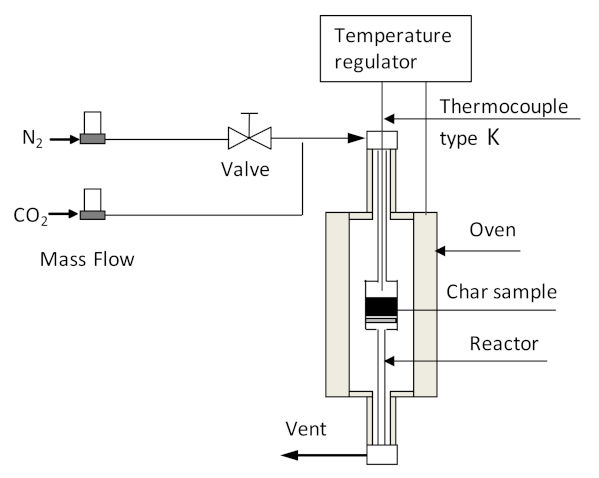
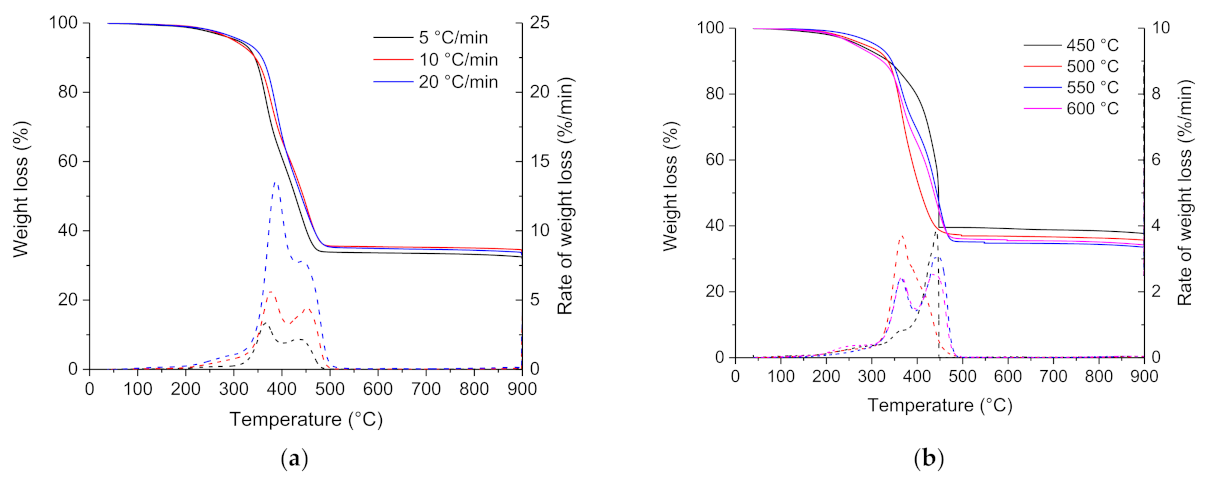
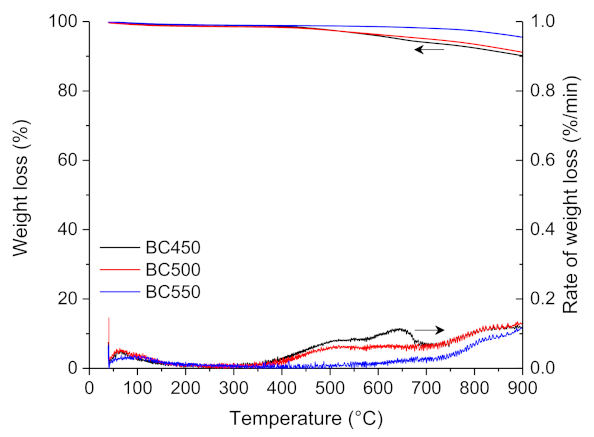

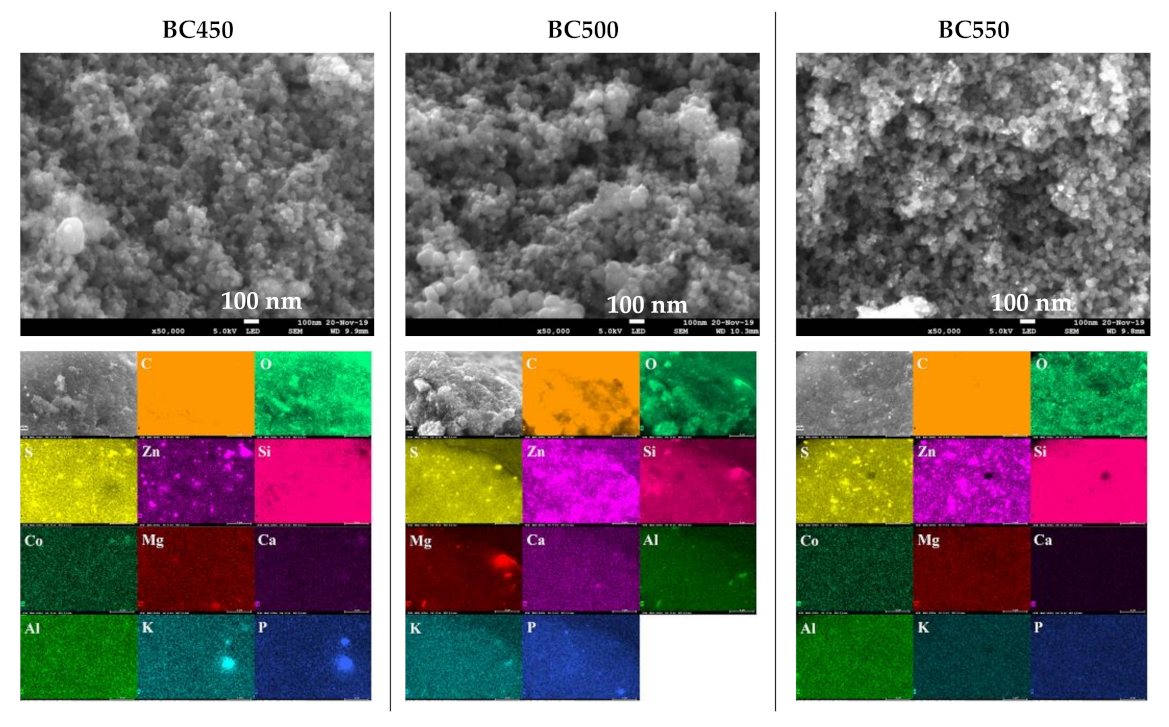
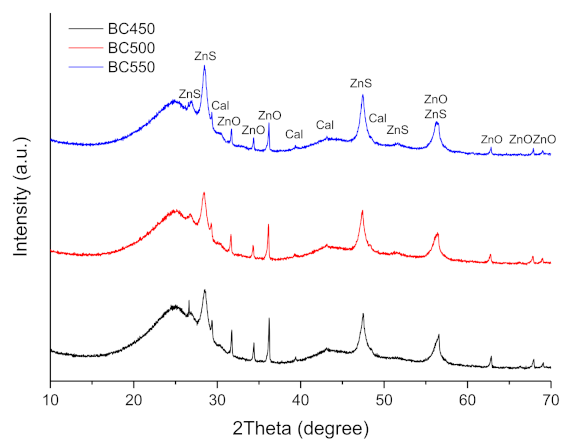

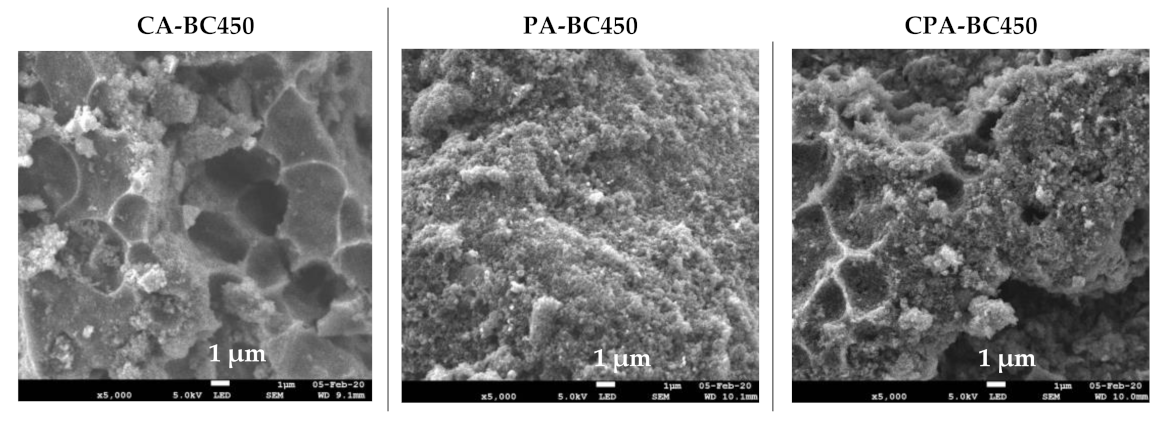
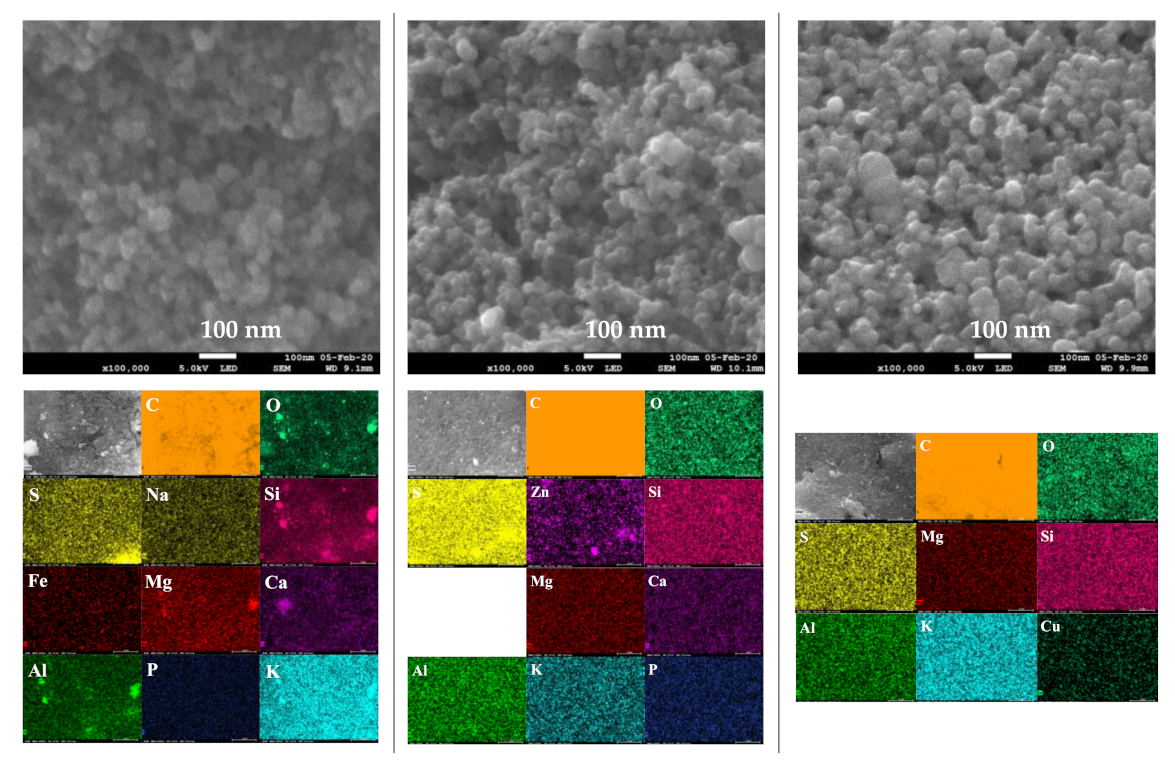
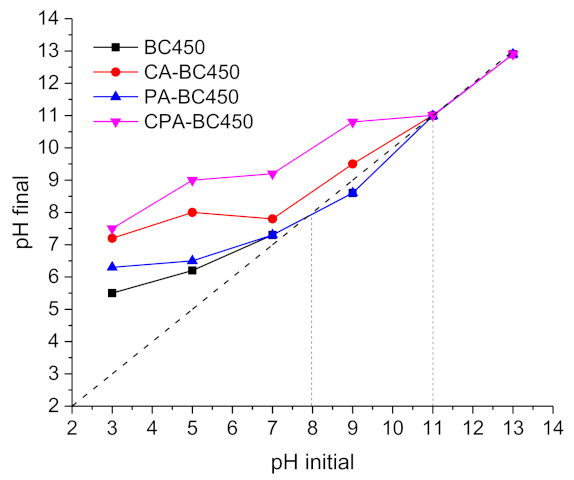

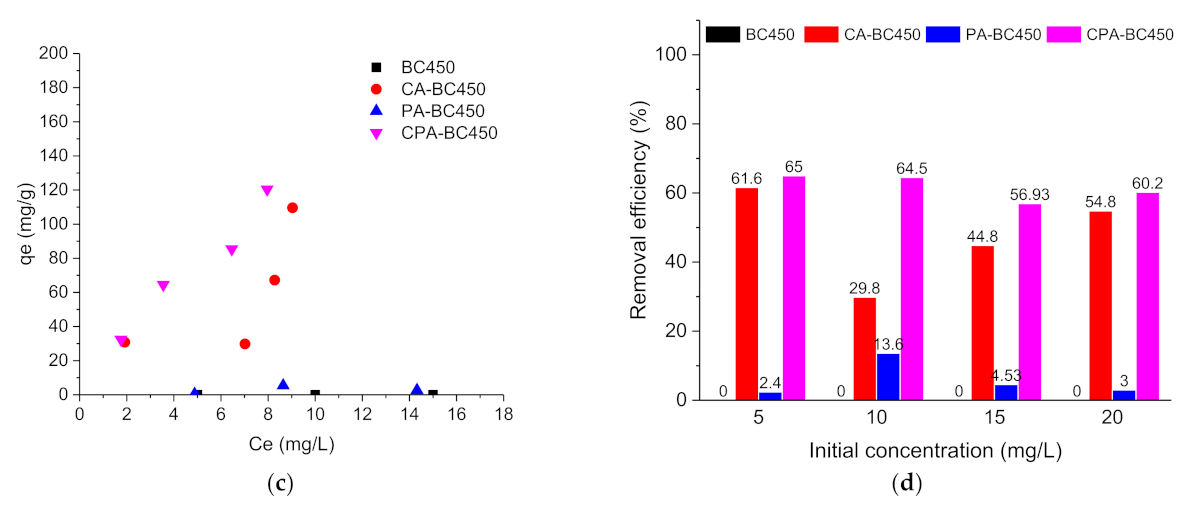
| Proximate Analysis (wt.%, as Received) | Analysis Method | Result |
|---|---|---|
| Moisture | Thermogravimetric Analysis (TGA) | 0.4 |
| Volatile matter | 67.5 | |
| Fixed carbon | 27.3 | |
| Ash | 4.7 | |
| Elemental Analysis (mg kg−1, dry basis) | ||
| As | Inductively Coupled Plasma Mass Spectrometry (ICP-MS) | 0.05 |
| Cd | 0.05 | |
| Cr total | <0.25 | |
| Pb | 4.2 | |
| Mn | 1 | |
| Se | <0.5 | |
| Ba | 7.5 | |
| B | 1.5 | |
| Sb | <0.5 | |
| Co | <0.05 | |
| Sr | 0.85 | |
| Sn | <0.5 | |
| Al | Inductively Coupled Plasma Atomic Emisssion Spectrometry (ICP-AES) | 16.5 |
| Cu | 122 | |
| Ni | <0.25 | |
| Zn | 700 | |
| Cr III | NF EN ISO 11885 | <0.25 |
| Cr VI | NF T 90-043 | <0.20 |
| Hg | NF EN ISO 17852 | <0.005 |
| Total Polycyclic Aromatic Hydrocarbon (mg kg−1, dry basis) | US EPA 8270 | <43.26 |
| Experimental Protocol for Non-Isothermal Tests: Study of the Influence of Heating Rate | ||
|---|---|---|
| Step | Description | Stage |
| 1 | hold for 10 min at 35 °C under N2 | initial |
| 2 | ramp to 900 °C with ramp rate of 5, 10 and 20 °C min−1 under N2 | heating |
| 3 | hold at 900 °C for 10 min under N2 | isothermal |
| 4 | hold at 900 °C for 60 min under air | isothermal |
| 5 | cool to room temperature under air | cooling |
| Experimental Protocol for Isothermal Tests: Study of the Influence of Pyrolysis Temperature | ||
| Step | Description | Stage |
| 1 | hold for 10 min at 35 °C under N2 | initial |
| 2 | ramp to T pyrolysis with ramp rate of 5 °C min−1 under N2 | heating |
| 3 | hold at T pyrolysis for 3 h under N2 | isothermal |
| 4 | ramp to 900 °C with ramp rate of 5 °C min−1 under N2 | heating |
| 5 | hold at 900 °C for 60 min under N2 | isothermal |
| 6 | hold at 900 °C for 10 min under air | isothermal |
| 7 | cool to room temperature under air | cooling |
| Adsorbates | Type | Molecule Structure | Molecule Size * | Solubility in Water (mg L−1) |
|---|---|---|---|---|
| Atrazine C8H14ClN5 | Herbicide | 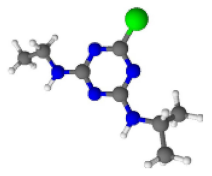 | Width ≈ 1 nm Depth ≈ 0.8 nm | 21 (at 25 °C) |
| Ibuprofen C13H18O2 | Anti-inflammatory drug | 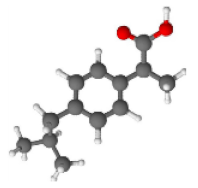 | Width ≈ 1.3 nm Depth ≈ 0.5 nm | 33 (at 25 °C) |
| Heating Rate (°C min−1) | Volatiles (wt.%) | Fixed Carbon (wt.%) | Ash (wt.%) | Char Yield (wt.%) |
|---|---|---|---|---|
| 5 | 67.8 | 27.5 | 4.7 | 32.2 |
| 10 | 65.8 | 31.4 | 2.7 | 34.2 |
| 20 | 66.9 | 29.2 | 4.0 | 33.1 |
| Temperature (°C) | Volatiles (wt.%) | Fixed Carbon (wt.%) | Ash (wt.%) | Char Yield (wt.%) |
| 450 | 60.3 | 26.3 | 13.4 | 39.7 |
| 500 | 63.0 | 35.8 | 1.2 | 37.0 |
| 550 | 65.2 | 34.0 | 0.8 | 34.8 |
| 600 | 64.4 | 30.5 | 5.1 | 35.6 |
| Reactor Type | Temperature (°C) | Solid Yield (wt.%) | Liquid Yield (wt.%) | Gas Yield (wt.%) | Reference |
|---|---|---|---|---|---|
| Pilot-scale static bed | 450 | 38.1 | 29.7 | 32.2 | This study |
| 500 | 37.8 | 30.5 | 31.7 | ||
| 550 | 37.8 | 34.2 | 28.0 | ||
| Laboratory-scale static bed batch | 400 | 55.9 | 24.8 | 19.3 | [12] |
| 500 | 44.8 | 38.0 | 17.2 | ||
| 600 | 44.2 | 38.2 | 17.5 | ||
| Pilot-scale continuous rotary kiln | 450 | 43.9 | 43.0 | 13.1 | [64] |
| 500 | 41.3 | 45.1 | 13.6 | ||
| 550 | 39.9 | 44.6 | 15.5 | ||
| Pilot-scale static bed batch | 450 | 37.4 | 58.1 | 4.5 | [65] |
| 500 | 38.3 | 56.2 | 5.5 | ||
| 600 | 38.0 | 53.1 | 8.9 | ||
| Pilot-scale fluidized bed | 500 | 30.0 | 65.0 | 5.0 | [66] |
| 550 | 34.0 | 57.0 | 9.2 | ||
| 600 | 40.0 | 51.0 | 9.1 |
| Rubber Size (mm) | Temperature (°C)/Heating Rate (°C min−1) | Residence Time (min) | Activating Agent/Weight Ratio | Activated Carbon Yield (wt.%) | Reference |
|---|---|---|---|---|---|
| 1.5–4 | 700/5 | 180 | KOH/(1:3) | 70 | Present study |
| 1.5–4 | 850/5 | 120 | CO2 | 87 | Present study |
| 1.5–4 | 700/5 and 700/5 | 180 and 20 | KOH/(1:3) and CO2 | 57 | Present study |
| 1.1–1.7 | 700/3 | 60 | KOH/(1:2) | 81 | [68] |
| 1.1–1.7 | 750/3 | 60 | KOH/(1:4) | 74 | [68] |
| 1.5–2.0 | 900/N.M | 120 | CO2 | 93 | [69] |
| N.M | 875/20 | 100 | CO2 | 88 | [40] |
| 0.5–1 | 850/N.M | 120 | CO2 | 62 | [70] |
| BC450 | BC500 | BC550 | |
|---|---|---|---|
| Proximate Analysis (wt.%, dry basis) | |||
| Total volatile matter | 9.3 | 8.1 | 4.1 |
| Fixed carbon | 78.0 | 79.5 | 86.5 |
| Ash | 12.7 | 12.5 | 9.4 |
| Elemental analysis * (wt.%, dry basis) | |||
| C | 86.69 | 88.05 | 90.90 |
| O | 6.41 | 5.59 | 4.10 |
| Mg | 0.10 | 0.11 | 0.12 |
| Al | 0.11 | 0.11 | 0.22 |
| Si | 2.81 | 2.05 | 0.63 |
| P | 0.02 | 0.02 | 0.02 |
| S | 1.66 | 1.66 | 1.67 |
| Cl | 0.02 | 0.04 | 0.04 |
| K | 0.04 | 0.04 | 0.04 |
| Ca | 0.07 | 0.04 | 0.11 |
| Fe | 0.04 | 0.05 | 0.04 |
| Co | 0.03 | 0.03 | 0.05 |
| Zn | 1.92 | 2.15 | 1.95 |
| Br | 0.06 | 0.06 | 0.06 |
| Textural Properties | |||
| BET surface area (N2) (m2 g−1) | 81.87 | 85.88 | 71.41 |
| Total pore volume (N2) (cm3 g−1) | 0.55 | 0.58 | 0.53 |
| Average pore width ** (N2) (nm) | 27.16 | 34.05 | 34.35 |
| BET surface area (CO2) (m2 g−1) | 57.08 | 76.15 | 63.58 |
| ID/IG ratio | 0.63 | 0.89 | 1.30 |
| Elemental Analysis (wt.%, Dry Basis) | CA-BC450 | PA-BC450 | CPA-BC450 |
|---|---|---|---|
| C | 95.96 | 86.90 | 96.13 |
| O | 1.70 | 6.36 | 1.60 |
| Mg | 0.16 | 0.07 | 0.17 |
| Al | 0.27 | 0.48 | 0.24 |
| Si | 0.64 | 3.11 | 0.59 |
| P | 0.00 | 0.02 | 0.00 |
| S | 0.26 | 1.23 | 0.22 |
| Cl | 0.02 | 0.00 | 0.00 |
| K | 0.73 | 0.04 | 0.80 |
| Ca | 0.11 | 0.08 | 0.11 |
| Fe | 0.04 | 0.06 | 0.05 |
| Co | 0.03 | 0.02 | 0.03 |
| Cu | 0.00 | 0.01 | 0.01 |
| Zn | 0.00 | 1.60 | 0.00 |
| Br | 0.01 | 0.01 | 0.00 |
| Zr | 0.02 | 0.01 | 0.01 |
| Textural Properties | |||
| BET surface area (N2) (m2 g−1) | 493.75 | 164.33 | 490.28 |
| Total pore volume (N2) (cm3 g−1) | 0.48 | 0.72 | 0.50 |
| Average pore width (N2) (nm) | 14.97 | 35.12 | 13.35 |
| BET surface area (CO2) (m2 g−1) | 308.54 | 117.69 | 279.33 |
| ID/IG Ratio | 1.41 | 1.44 | 1.40 |
| Rubber Size (mm) | Activation Temperature (°C)/Heating Rate (°C min−1) | Residence Time (min) | Activating Agent/Weight Ratio | BET Surface (m2g−1)/Mesopore Volume (cm3g−1) | Reference |
|---|---|---|---|---|---|
| 1.5–4 | - | - | - | 81/0.55 | This study |
| 1.5–4 | 700/5 | 180 | KOH/(1:3) | 494/0.48 | This study |
| 1.5–4 | 850/5 | 120 | CO2 | 164/0.72 | This study |
| 1.5–4 | 700/5 and 700/5 | 180 and 20 | KOH/(1:3) and CO2 | 490/0.50 | This study |
| 1.1–1.7 | 700/3 | 60 | KOH/(1:2) | 166/0.56 | [68] |
| 1.5–2 | 700/20 | 120 | KOH/(1:3) | 170/0.69 | [71] |
| 1.1–1.7 | 750/3 | 60 | KOH/(1:4) | 405/0.61 | [68] |
| 1.5–2.0 | 900/N.M | 120 | CO2 | 91/N.M | [69] |
| N.M | 875/20 | 100 | CO2 | 239/N.M | [40] |
| 0.5–1 | 850/N.M | 120 | CO2 | 399/0.26 | [70] |
| Adsorbate | Adsorbent | Isotherm Model | Parameters | R2 | |
|---|---|---|---|---|---|
| Atrazine | CA-BC450 | Langmuir | qmax (mg g−1), KL (L mg−1) | 181.8, 1.000 | 0.999 |
| Freundlich | KF (mg g−1), n | 92.7, 3.148 | 0.991 | ||
| CPA-BC450 | Langmuir | qmax (mg g−1), KL (L mg−1) | 208.3, 1.714 | 0.997 | |
| Freundlich | KF (mg g−1), n | 125.0, 2.925 | 0.915 | ||
| Ibuprofen | CA-BC450 | Freundlich | KF (mg g−1), n | 0.001, 0.195 | 0.999 |
| CPA-BC450 | Freundlich | KF (mg g−1), n | 25.6, 1.416 | 0.895 | |
| Adsorbate | Adsorbent | Particle Size (mm) | BET (m2·g−1) | Adsorbent Dosage | Concentration (mg L−1) | T | qmax (mg·g−1) | Reference |
|---|---|---|---|---|---|---|---|---|
| Atrazine | Waste tire-AC * | 0.25−0.4 | 490 | 4 mg/40 mL | 5−20 | 18 | 208 | This study |
| Atrazine | Hemp stem-AC | 0.5−1.0 | 2135 | 5–100 mg/100 mL | 30 | N.M | 200 | [81] |
| Atrazine | Commercial-AC | N.M | 666 | 10 mg | 2−25 | N.M | 30 | [82] |
| Atrazine | Soybeans-BC ** | <0.6 | 17.5 | 200 mg/100 mL | 5−35 | 18 | 1.4 | [83] |
| Atrazine | Corn stalks-BC | <0.6 | 19.6 | 200 mg/100 mL | 5−35 | 18 | 1 | [83] |
| Atrazine | Rice stalks-BC | <0.6 | 25.8 | 200 mg/100 mL | 5−35 | 18 | 1.2 | [83] |
| Atrazine | Corn straw-BC | <2 | 45 | 50 mg/100 mL | 5−25 | 25 | 7 | [84] |
| Ibuprofen | Waste tire-AC | 0.25−0.4 | 490 | 4 mg/40 mL | 5−20 | 18 | - | This study |
| Ibuprofen | Cork waste-AC | N.M | 891 | 10 mg/15 mL | 20−60 | 30 | 85 | [85] |
| Ibuprofen | PET-AC | N.M | 1426 | 2.5–10 mg | 20–120 | 30 | 255 | [86] |
| Ibuprofen | Commercial-AC (Coal) | N.M | 1156 | 2.5–10 mg | 20–120 | 30 | 360 | [86] |
| Ibuprofen | Commercial-AC (Wood) | N.M | 899 | 2.5–10 mg | 20–120 | 30 | 275 | [86] |
Publisher’s Note: MDPI stays neutral with regard to jurisdictional claims in published maps and institutional affiliations. |
© 2022 by the authors. Licensee MDPI, Basel, Switzerland. This article is an open access article distributed under the terms and conditions of the Creative Commons Attribution (CC BY) license (https://creativecommons.org/licenses/by/4.0/).
Share and Cite
Frikha, K.; Limousy, L.; Pons Claret, J.; Vaulot, C.; Pérez, K.F.; Garcia, B.C.; Bennici, S. Potential Valorization of Waste Tires as Activated Carbon-Based Adsorbent for Organic Contaminants Removal. Materials 2022, 15, 1099. https://doi.org/10.3390/ma15031099
Frikha K, Limousy L, Pons Claret J, Vaulot C, Pérez KF, Garcia BC, Bennici S. Potential Valorization of Waste Tires as Activated Carbon-Based Adsorbent for Organic Contaminants Removal. Materials. 2022; 15(3):1099. https://doi.org/10.3390/ma15031099
Chicago/Turabian StyleFrikha, Kawthar, Lionel Limousy, Joan Pons Claret, Cyril Vaulot, Karin Florencio Pérez, Beatriz Corzo Garcia, and Simona Bennici. 2022. "Potential Valorization of Waste Tires as Activated Carbon-Based Adsorbent for Organic Contaminants Removal" Materials 15, no. 3: 1099. https://doi.org/10.3390/ma15031099







